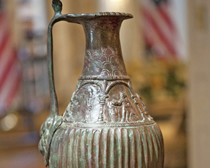Seize and Send: No Arrests Announced as ICE Sends Evidence Back to Afghanistan
 |
| Roman oinochoe. Courtesy of ICE. |
U.S. Immigration and Customs Enforcement (ICE) this week sent back evidence of cultural heritage trafficking to Afghanistan without making any arrests. The items returned include an ancient Roman oinochoe (right), 5th century B.C. gold foil appliques, and 17th century gold ornaments.
U.S. Customs and Border Protection (CBP) and the Homeland Security Investigations (HSI) New York El Dorado Task Force seized the objects at Newark Liberty International Airport’s cargo facility on March 21, 2011, says ICE. An ICE news release reports that “HSI New York special agents discovered they were destined for a New York City man and later to a New York business suspected of dealing in looted cultural property. Through the investigative process, the antiquities were found to have originated in Afghanistan.”
Customs administratively forfeited the items on Jan. 25, 2012. It may be reasonable to infer that those responsible for the illegal trafficking operate in the U.S., Great Britain, and the Middle East judging from ICE’s announcement that “HSI New York, London and Dubai are conducting this ongoing investigation.”
HSI Assistant Director John Connolly is quoted as saying, “Today marks HSI’s fourth cultural repatriation to Afghanistan since 2005. We are committed to the continued cooperation between our countries and beating back this illicit trade through dedicated law enforcement efforts, partnerships and training thus preserving and protecting the world’s ancient and valued treasures.” Connolly’s prepared remarks make no mention of either arrests or indictments.
The pattern of ICE returning evidence of cultural heritage trafficking without prosecution is common. There is an apparent policy of “seize and send” promoted by ICE leadership whereby the agency seizes illegally stolen or smuggled cultural objects and sends them back to their country of origin. This policy has been criticized before because it overemphasizes the recovery and repatriation of cultural heritage objects at the expense of investigating and indicting smugglers, fences, and receivers of stolen property who knowingly contribute to the destruction of cultural heritage. It is expected that fraud, money laundering, and other felony crimes too escape criminal prosecution as traffickers convert illegally obtained antiquities into cash.
While ICE’s financial crimes investigations yield numerous arrests and prosecutions, ICE’s cultural property, art, and antiquities investigations do not regularly result in criminal prosecutions.
HSI claims that its investigation surrounding the Afghani objects returned this week is “ongoing.” But what direction the investigation is going in remains unclear. Will criminal indictments be pursued? Or will ICE’s latest repatriation of cultural artifacts serve as a further reminder that the agency’s leadership will seize cultural contraband but not arrest the criminals who unlawfully steal, smuggle, transport, sell, or buy them?
This post is researched, written, and published on the blog Cultural Heritage Lawyer Rick St. Hilaire at culturalheritagelawyer.blogspot.com. Text copyrighted 2010-2013 by Ricardo A. St. Hilaire, Attorney & Counselor at Law, PLLC. Any unauthorized reproduction or retransmission of this post is prohibited. CONTACT INFORMATION: www.culturalheritagelawyer.com

